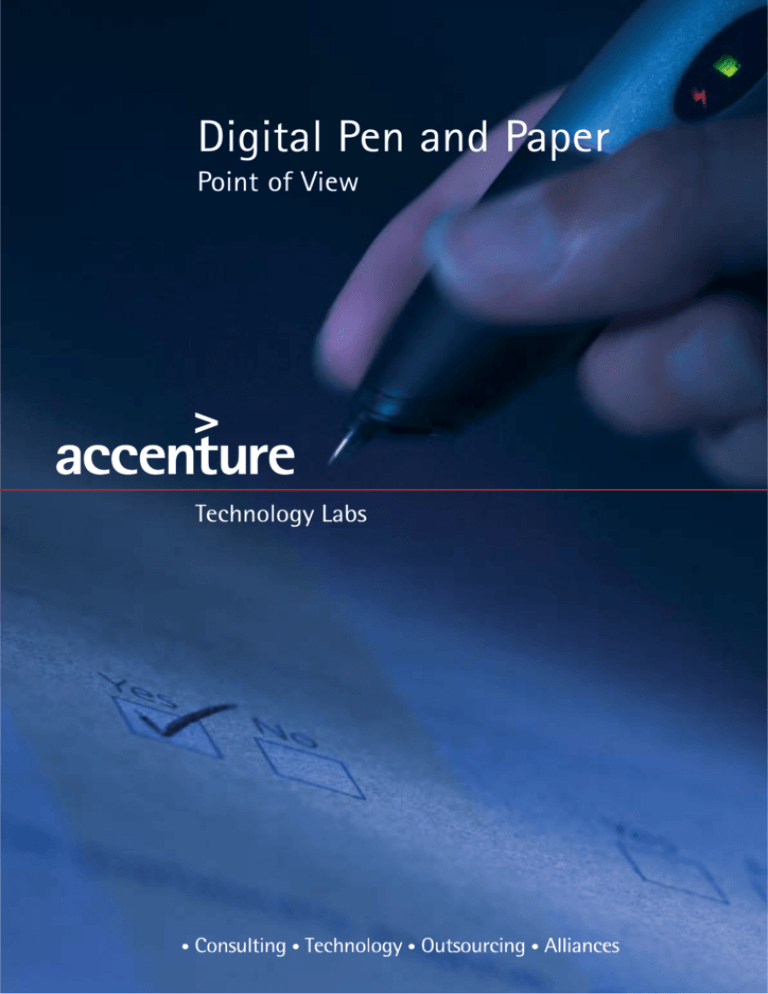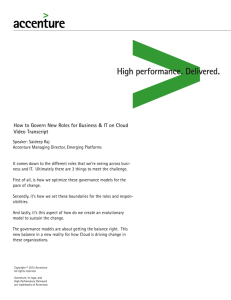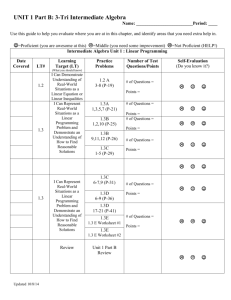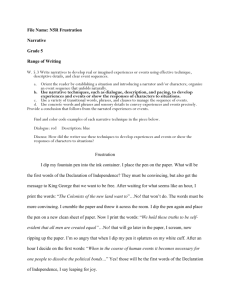
Digital Pen and Paper
Point of View
Digital pen and paper provides
a cost-effective way for
traditional paper processes
to enter the digital world.
Business still relies heavily on pen and paper. This may be for legal
reasons or convenience, because some users are uneasy about
making a full switch to the electronic world or because it is simply
too costly to equip a large team of field workers with individual
computing devices. Yet handling forms, receipts, and other paper
documents often slows down essential processes and generates
costly bottlenecks for many businesses. And at some point, this
data needs to be incorporated into an enterprise’s computing systems.
Digital pen and paper provides a cost-effective way for
traditional paper processes to enter the digital world by
fusing the traditional means of information-gathering with
electronic communications. Until recently, consumers have
been the primary target audience for digital pen and paper
technology. Accenture Technology Labs, the technology
research and development organization within Accenture,
has developed in-depth experience of the technology and
believes that it is now mature enough to make a radical
difference in enterprises. In collaboration with client teams,
the Labs are inventing assets that make this technology
innovation relevant to a number of industries.
Making its mark
Digital pen and paper technology combines the portability
and social acceptance of traditional pen and paper with a
computer’s ability to store, share, and act upon the
information collected.
Digital pens are used like ordinary pens – only they are
embedded with electronics capable of storing time-stamped
content. Users write on paper printed with a faint irregular
pattern of dots similar to map coordinates, enabling the pen
to know which form is being used, what is being written,
where on the form and when. For increased security, each
pen has a unique identifier allowing all information recorded
by it to be traced back to the source. The data stored in the
pen is transmitted through a synching inkwell or a Bluetooth
mobile phone to a central server for storage, further
processing and analysis, or transmission to colleagues.
The Labs considers digital pen and paper to be especially
relevant in situations requiring a significant amount of
forms processing, and when information such as signatures
and figures needs to be collected, or a paper-based item such
as a receipt provided – either in or away from the office.
In workflow situations that involve multiple hand-offs
between departments, digital pen and paper technology
can reduce cost sixfold.
Digital pen and paper technology can be easily introduced –
at a manageable cost – to users who are unfamiliar with or
wary of new technologies. For example, in industries that
have tried and trusted paper-based processes, digital pen
and paper enables a new level of efficiency without
disrupting working procedures.
The universal benefits
of introducing this
technology include:
• speedier forms processing
– written information is
electronically transmitted to a
central database where it can
be accessed by authorized parties,
without having to wait for it to be
re-keyed into an enterprise’s system.
Quicker access to information can
improve customer service;
• automatic backup – digital pen
and paper creates a virtual double
of records and forms that can be
accessed enterprise-wide or by
authorized external entities, while
guarding a paper trace if required.
This should help improve reporting
and compliance where needed;
• transparent transition and
acceptance of a new technology –
the pens are so easy to use that
little to no training is required.
Users can perform their duties as
they always have while benefiting
from improved performance.
Furthermore, digital pen and paper
is less physically intrusive than PCs
or laptops in situations such as
financial discussions or census
interviews;
• traceability – the paper can have
unique identifiers which enable the
pen to track and identify signatories.
Information is traceable back to a
specific pen and data is timestamped for added accountability.
Equipping workers with a digital pen
and paper for forms processing would
cost a fraction of supplying them with
computers or mobile devices – both
initially and for replacements. With
a relatively modest investment and
minimal instruction, companies could
achieve significant cost savings,
streamline processes, and get a
headstart on the competition.
In Accenture’s opinion, the following industries in particular
should consider the potential of digital pen and paper technology:
Financial services – speeding
up paper-based procedures.
Speeding up the claims process
The insurance industry could save
money by reducing the costs linked to
paper processing and increase revenue
through not losing life assurance
customers during a lengthy approval
process. Similarly, banks could save
money and improve customer services
in areas such as loan applications or
setting up new accounts, by reducing
response time to days or even hours.
For both industries, digital pen and
paper would maintain the legal
protection of having original
signatures on forms, and retain the
human touch (as opposed to
mechanical) which is essential when
discussing and recording sensitive
information. This technology offers the
opportunity to begin digitizing paper
processes while financial institutions
can further explore digital signatures.
Healthcare – enhancing
the safety, quality, and
efficiency of patient care.
Digital pen and paper could be used
to modernize the time-consuming,
manual task of completing patient
observation charts (see side-bar).
Information recorded by the pen
would be transmitted to a central
server and integrated into an
electronic patient record which could
be accessed by authorized third
parties such as other attending
physicians, insurance companies, and
pharmacies. Another use could be in
combating fraud. The UK Health
Service estimates that prescription
falsification costs them over $100m
per year. With digital pen and paper,
prescriptions would be digitally
transmitted from the doctor to the
hospital’s server and then to the
patient's designated pharmacy,
thus thwarting a person’s ability
to manipulate or forge what the
doctor ordered. Pharmacists would
have an online copy to compare to
a patient’s written prescription.
At Accenture Technology Labs, we are
building an application in the insurance
claims area that enables the capture of file
notes taken in the field to help speed up the
claims process.
Improving healthcare operations
Through access to an early version of the technology, Accenture Technology Labs
has developed the Digital Observations solution for the recording of patient
information. Nursing staff would use digital pen and paper to record patient
observations the way they normally do. Whatever is recorded on the charts
would be digitally recorded by the pen, transmitted to the hospital’s central
server, and could be consulted whenever and wherever the attending physicians
required, thereby creating a virtual double of the hard copy.
Benefits
Doctors would still make their rounds, but would be able to access patients’
charts prior to visiting them and prioritize visits as needed or view a patient's
progress over time electronically.
Staff efficiency and patient care could be improved through the solution’s
ability to alert staff when a patient's vital signs exceed safe thresholds or when
their medication has not been given (especially relevant for those medicines
where very accurate timing is vital).
The Accenture Digital Observations solution can optimize the usage of staff time,
enhance human performance, and reassure patients, without requiring special
skills or training to implement it.
It illustrates a key aspect of the Reality Online technology vision where people
are able to access and manage the physical world online through the creation
of virtual doubles of physical objects or events. For more information on Reality
Online, visit: www.accenture.com/realityonline
In Accenture’s opinion, the following industries in particular
should consider the potential of digital pen and paper technology:
Manufacturing – aiding
in quality control and safety
check-ups.
Manufacturing a car requires more
than 15,000 parts and accessories
which must fit and work together
perfectly even though they might be
made by many different companies, in
different countries.* Cars on assembly
lines could be issued with a checklist
which workers could quickly complete
with a digital pen for each vehicle
they work on. This information could
be fed into a central system where
managers and other concerned parties
could constantly monitor quality.
The technology could also be used for
collecting and transmitting safetycritical information from aircraft and
machine maintenance where the
added safety of the pen’s time-stamp
and unique identification features
would prove invaluable.
Government bureaus
– improving the quality
of public services.
The UK’s Police Magazine reported
that of the 43.1 percent of time
spent by officers in police stations,
40 percent is spent on paperwork**.
Digital pen and paper could help
reduce the enormous amount of time
involved filling in forms such as
incident reports, so that police would
have more time to proactively serve
the public. The postal service could
use this technology for tracking
deliveries, and filling in customs
forms. And census takers and pollsters
could be equipped with a digital pen
and paper to enable statistics to be
tallied more rapidly and securely.
*NIST website – National Institute of Standards and Technology
**Police Magazine, February 2002 – ‘Bureaucracy Busters’
Composing the write strategy
Digital pen and paper is an emerging technology set to take
off. As the cost of the pens decreases, Accenture Technology
Labs believes that their use will become more widespread, and
that new features and innovations will be introduced. In the
meantime, innovative companies can gain competitive
advantage by:
1. identifying areas where costs are high because of the current use of pen and
paper, where processes could be accelerated to give competitive edge, or where
new revenue streams could be generated through the introduction of the digital
pen and paper;
2. conducting a value-targeting exercise to determine how digital pen and paper
technology can be applied to address your company’s key business issues and
integrated into your overall infrastructure – including enterprise applications,
mobile devices, and IT platform;
3. developing a business case for incorporating digital pen and paper technology;
4. rolling out a pilot to test its effectiveness and acceptance.
Right technology at the right time
Depending on what a mobile workforce needs to achieve, one type of mobile
technology or a mix of several might be appropriate. For example, if workers need
to access or retrieve information, digital pen and paper technology is unlikely to
replace PC, PDA, and other mobile devices. However, in the specific scenario of
checking and managing hospital observation charts, the Labs demonstrates how
digital pen and paper can be integrated seamlessly with tablet PCs to help doctors
and patients alike.
About Accenture Technology Labs
Accenture Technology Labs, the technology research and development (R&D)
organization within Accenture, has a 16-year track record of turning technology
innovation into business results. The Labs create a vision of how technology will
shape the future and invent the next wave of cutting-edge business solutions.
Working closely with Accenture's global network of specialists, Accenture
Technology Labs helps clients innovate for competitive advantage. Labs are
located in Chicago, Illinois; Palo Alto, California; and Sophia Antipolis, France.
For more information, please visit our website at
www.accenture.com/accenturetechlabs
About Accenture
Accenture is a global management consulting and technology services company.
Committed to delivering innovation, Accenture collaborates with its clients to
help them realize their visions and create tangible value. With deep industry
expertise, broad global resources and proven experience in consulting and
outsourcing, Accenture can mobilize the right people, skills, alliances and
technologies. With more than 80,000 people in 47 countries, the company
generated net revenues of US$11.6 billion for the fiscal year ended August 31,
2002. Its home page is www.accenture.com.
For more information visit: www.accenture.com/accenturetechlabs.
© 2003 Accenture. All rights reserved. Accenture and its logo,
and Accenture Innovation Delivered are trademarks of Accenture.







